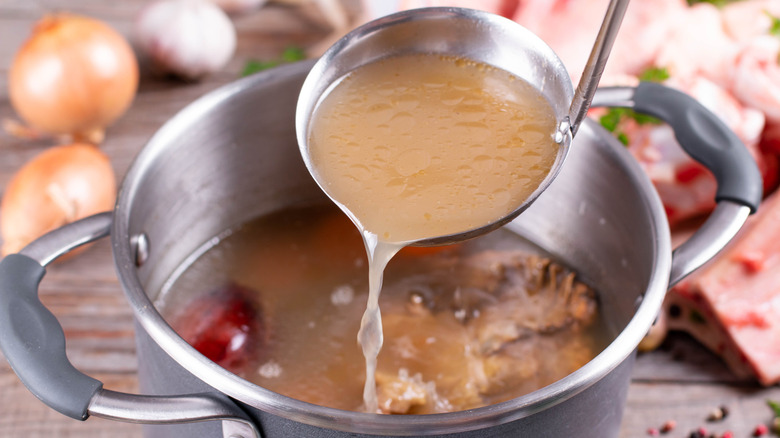Martha Stewart's Flavorful Tip For Making Beef Stock
Whether you know her from "Martha Bakes" or her several well-known cookbooks, Martha Stewart has built a successful empire that has allowed her to connect with home cooks and chefs around the world, especially when it comes to cooking tips (via Investopedia).
Stewart knows a few tricks for elevating sweet and savory recipes alike, and some of our favorites are for soups and stews. For instance, if a chilly night calls for homemade butternut squash soup, Stewart suggests boiling and roasting the seeds instead of throwing them away, per Love Food. That way, the creaminess of the soup is contrasted by these crunchy garnishes. Or, if you find that your next batch of soup is too salty, add some lemon juice or red wine vinegar (via Martha Stewart). She even proves that stews can be whipped up in as little as 30 minutes, evidenced by her half-hour chicken gumbo recipe. The secret is to use pre-cooked sausage, rotisserie chicken, and frozen okra to speed up the process.
Soups and stews often require stock, and Stewart offers many variations and tips on producing beef stock. Here's one of our favorites from her YouTube channel.
Rinse out the roasting pan
MasterClass says a good beef stock utilizes a mirepoix, bones, and aromatics, all of which are cooked together for up to six hours. Compared to a thinner and less substantial broth, a stock needs more time on or under the heat to draw out the gelatin in the bones for thickening.
Stewart's take on beef stock, as seen on her YouTube channel, first requires roasting veal and oxtail bones in a 400 degree Fahrenheit oven for 45 minutes. She then adds roughly cut veggies, aromatics, and tomato paste to the pan and continues to roast for another 40 minutes. After this, she places the bones and veggies into a deep stockpot, drains off the fat, and deglazes the roasting pan with red wine. After the alcohol is burned off, Stewart pours the fond into the stockpot with the bones and vegetables, which she then covers with at least two inches of water.
But Stewart isn't one to waste what's left in the roasting pan. To ensure more flavor in the stock, she takes the pan, adds a little bit of water, and pours any remaining browned bits and red wine into the pot. Without this step, those flavors would go to waste, so why not use them to make a better stock?

